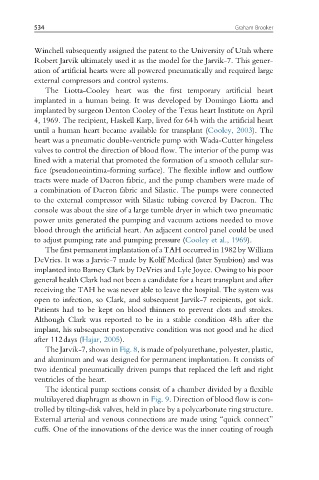Page 540 - Handbook of Biomechatronics
P. 540
534 Graham Brooker
Winchell subsequently assigned the patent to the University of Utah where
Robert Jarvik ultimately used it as the model for the Jarvik-7. This gener-
ation of artificial hearts were all powered pneumatically and required large
external compressors and control systems.
The Liotta-Cooley heart was the first temporary artificial heart
implanted in a human being. It was developed by Domingo Liotta and
implanted by surgeon Denton Cooley of the Texas heart Institute on April
4, 1969. The recipient, Haskell Karp, lived for 64h with the artificial heart
until a human heart became available for transplant (Cooley, 2003). The
heart was a pneumatic double-ventricle pump with Wada-Cutter hingeless
valves to control the direction of blood flow. The interior of the pump was
lined with a material that promoted the formation of a smooth cellular sur-
face (pseudoneointima-forming surface). The flexible inflow and outflow
tracts were made of Dacron fabric, and the pump chambers were made of
a combination of Dacron fabric and Silastic. The pumps were connected
to the external compressor with Silastic tubing covered by Dacron. The
console was about the size of a large tumble dryer in which two pneumatic
power units generated the pumping and vacuum actions needed to move
blood through the artificial heart. An adjacent control panel could be used
to adjust pumping rate and pumping pressure (Cooley et al., 1969).
The first permanent implantation of a TAH occurred in 1982 by William
DeVries. It was a Jarvic-7 made by Kolff Medical (later Symbion) and was
implanted into Barney Clark by DeVries and Lyle Joyce. Owing to his poor
general health Clark had not been a candidate for a heart transplant and after
receiving the TAH he was never able to leave the hospital. The system was
open to infection, so Clark, and subsequent Jarvik-7 recipients, got sick.
Patients had to be kept on blood thinners to prevent clots and strokes.
Although Clark was reported to be in a stable condition 48h after the
implant, his subsequent postoperative condition was not good and he died
after 112days (Hajar, 2005).
The Jarvik-7, shown in Fig. 8, is made of polyurethane, polyester, plastic,
and aluminum and was designed for permanent implantation. It consists of
two identical pneumatically driven pumps that replaced the left and right
ventricles of the heart.
The identical pump sections consist of a chamber divided by a flexible
multilayered diaphragm as shown in Fig. 9. Direction of blood flow is con-
trolled by tilting-disk valves, held in place by a polycarbonate ring structure.
External arterial and venous connections are made using “quick connect”
cuffs. One of the innovations of the device was the inner coating of rough

